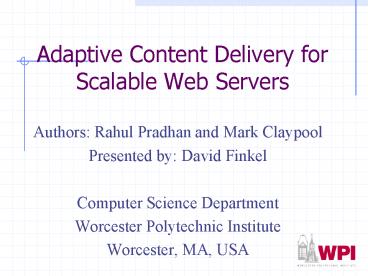Adaptive Content Delivery for Scalable Web Servers - PowerPoint PPT Presentation
Title:
Adaptive Content Delivery for Scalable Web Servers
Description:
Adaptive Content Delivery for Scalable Web Servers. Authors: Rahul ... Using 'thumbnails' instead of full, inline images. Reducing the number of local links ... – PowerPoint PPT presentation
Number of Views:35
Avg rating:3.0/5.0
Title: Adaptive Content Delivery for Scalable Web Servers
1
Adaptive Content Delivery for Scalable Web
Servers
- Authors Rahul Pradhan and Mark Claypool
- Presented by David Finkel
- Computer Science Department
- Worcester Polytechnic Institute
- Worcester, MA, USA
2
Outline
- Introduction
- Managing Load
- Approach
- - Methodology
- - Design
- Experiments
- Client Side Experiments
- Future Work Conclusions
3
Introduction
- Enormous Growth of Web
- Exponential in number if users, pages, and sites
- New Web uses require different resources
- Static Disk, Network
- Dynamic CPU, Network
- Media streaming CPU, Disk, Network
4
Web Server Overload
- Loaded server rejects connections, denying
service - Companies lose revenue
- Loaded server increases response times
- Slower pages viewed as less interesting
5
Current Approaches to Managing Load
- Over provisioning
- Beef up single server
- Can still become loaded during flash crowds
- Load balancing
- Server farm or CDN
- Individual servers may still become over-loaded
- Content adaptation
- Reduce resources needed upon heavy load
6
Content Adaptation Examples
- Using thumbnails instead of full, inline images
- Reducing the number of local links
- Reducing the number of embedded objects
- Changing the quality of images
- Current approaches manual!
- Our approach is to adapt content automatically
7
Our Approach
- Two versions of Web pages
- High quality to serve under normal load
- Low quality to serve under high load
- Monitor the server load
- A separate light weight standalone process
- Upon heavy load, server switches to low quality
transparently - Requires no modification to
- Server
- Browser
- http protocol
8
Adaptive Content Delivery System Architecture
Base System
Our System
Requests
Adaptation Module
Web Server
Load Monitor
Disk
Response
Content Switching
CPU, Disk, Network
9
Load Monitor
- Continuously monitors the utilization of the
server and the observed response time - Developed utilities to measure utilization
- CPU, Network, Disk
- Observed Response Time
- Used Linux /proc file system, but techniques
general enough for any OS
10
Adaptation Module
- Input of load values from the load monitor
- Decides low or high load
- Low and high thresholds
- Threshold values determined by prior measurement
- Scripts to induce load on server
- httperf to generate requests
- measured response time (using httperf)
11
Response Time vs CPU Util
Thresholds 60 and 75
12
Content Selector
- Transparently switches content depending on the
decision made by the adaptation module. - We use symbolic links to make the same file
point - to different qualities of content.
- indexhigh.html
- index.html
- indexlow.html
13
Experiments
- Server
- P-III, 500,128 MB RAM, IDE, 10 Mpbs, Linux
2.2.14, Apache 1.3.12 - Workloads
- Static Workload
- Dynamic Workload
- Multimedia Workload
- Metrics
- Throughput (Responses/sec)
- Average Response Time
- Percentage of Errors
- Frame Rate (for Multimedia Clients)
14
Response Time (ms) vs Requests/sec
15
Percent Errors vs Requests/sec
16
Frame rate vs Number of MM Clients
17
Overhead For the Adaptive Content Delivery System
18
Client Side Experiments
- Experiments on real servers to determine
- the impact of file size on response time.
- Used a modified httperf for our
- measurements to generate requests
- Measured the response time along with
- the connection set up time and transfer time.
19
Conclusions
- Server load critical
- We present a mechanism to
- Quantify server load
- Adapat transparently to client
- Improves server performance
- supports 25 more static requests
- supports twice as many Multimedia clients
- supports 15 more CGI requests
20
Future Work
- Adapting to heterogeneous client environment
- Clients may have different bandwidths
- Adding QoS features to the Web server
- Range of content quality at server
- Maximize QoS for user
21
Adaptive Content Delivery for Scalable Web
Servers
- Authors Rahul Pradhan and Mark Claypool
- Presented by David Finkel
- Computer Science Department
- Worcester Polytechnic Institute
- Worcester, MA, USA
22
Extra slides past here .
23
JPEG Quality JPEG Quality Factor vs
Percentage Savings in File Size
24
MPEG Quality MPEG Q Scale Factor vs Percentage
File Size Savings
25
Response Time vs Number of CGI Requests
26
Percentage Of CGI Requests Rejected vs Number of
CGI Requests































